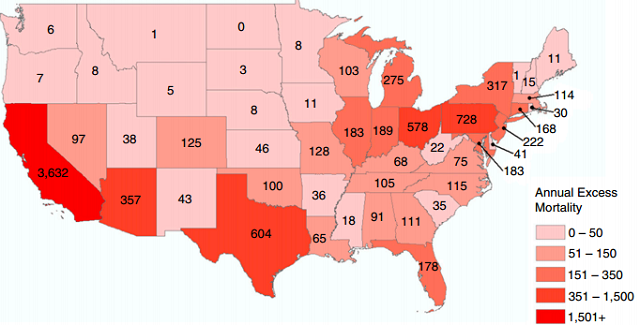Stricter Air Quality Standards Could Save Thousands Of Lives, Reduce Sick Days

A little cleaner air goes a long way, suggests a new report released Wednesday by the American Thoracic Society (ATS). The organization previously had released recommended air quality standards, so they decided to take a look at what would have happened if they had been followed.
They discovered there would have been approximately 9,320 fewer deaths, 21,400 fewer major health crises, like hospitalizations or heart attacks, and 19 million fewer sick days from school, work or other physical activities in a year’s time.
They also calculated which places would benefit most from lowering their current levels of air pollution, finding that the state of California alone accounted for 37 percent of the extra deaths and other health problems. The city of Los Angeles, notorious for its smoggy hazes, would avoid 1,341 deaths and prevent nearly 3 million sick days, making it the biggest potential winner from cleaner air. All told, the nearly 10,000 lives saved would come close to matching the annual number of lives lost to alcohol-fueled traffic accidents every year in the U.S.
The organization, in collaboration with the Marron Institute of Urban Management at New York University, analyzed nationwide air quality data from 2011 to 2013, specifically looking at the annual levels of two major sources of pollution — ozone (O3) and fine particulate matter smaller than 2.5 micrometers in diameter. They then calculated the health impacts that would have happened had these levels met the air quality standards previously created by the Thoracic Society, which are stricter than those issued by the Environmental Protection Agency (EPA).
"While there is information available about counties in the United States that exceed EPA air pollution standards, there has not been a similar source of information about how that air pollution actually affects the health of people living in those areas," said lead author Dr. Kevin Cromar, director of the Air Quality Program at the Marron Institute, in a statement.
The majority of added health risks found in the report came from ozone pollution, likely because overpollution of the latter was much more frequent. Fourteen percent of measured counties exceeded the ATS standards for particulate matter compared to 91 percent which did so for ozone. Both pollutants can come from many different sources, including car exhaust and industrial facilities.

The health benefits of even marginally cleaner air could add up significantly. In a separate analysis, the researchers estimated that if every county kept their ozone levels below the EPA standard, there would have been 2,650 fewer deaths and 7.5 million fewer sick days, a sharp drop from the 6,410 fewer deaths and 17 million fewer sick days seen with the ATS standard. Of course, when it comes to air pollution, there's really no point at which we wouldn't be healthier from having less of it around, a detail the researchers note.
Because the report only measured two of the six major sources of pollution tracked by the EPA, it’s likely the savings to our wellbeing could be even higher, the authors added. Other research has estimated that air pollution contributes to as many as 200,000 early deaths annually in the U.S., and 7 million worldwide.
"As an organization of health care providers and researchers, we know firsthand the toll air pollution takes on people's health, particularly the young and elderly," said Dr. David Gozal, ATS President and Herbert T. Abelson, professor of pediatrics at the University of Chicago. "This report begins to quantify that toll and provides information that, we believe, should inform the setting of national air pollution standards."
The ATS and Marron Institute plan to update their findings regularly, as part of an annual “Health of the Air” report. The findings were published in the Annals of the American Thoracic Society.
Source: Cromar K, Gladson L, Perlmutt L, et al. Estimated Excess Morbidity and Mortality Caused by Air Pollution above American Thoracic Society–Recommended Standards, 2011–2013. Annals of the American Thoracic Society. 2016.
Read More:
Lower Air Pollution Levels Linked To Fewer Asthma Symptoms, Respiratory Problems In Children. Read here.
Household Indoor Air Pollution Can Increase Heart Attack Risk; Where It Comes From And What We Can Do About It. Read here



























